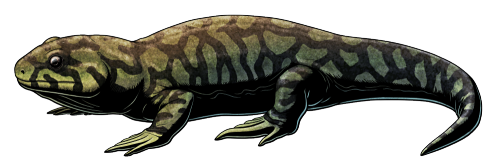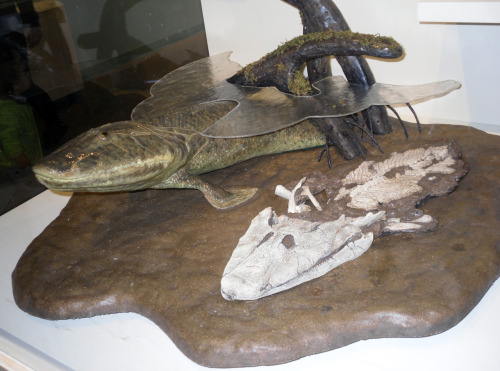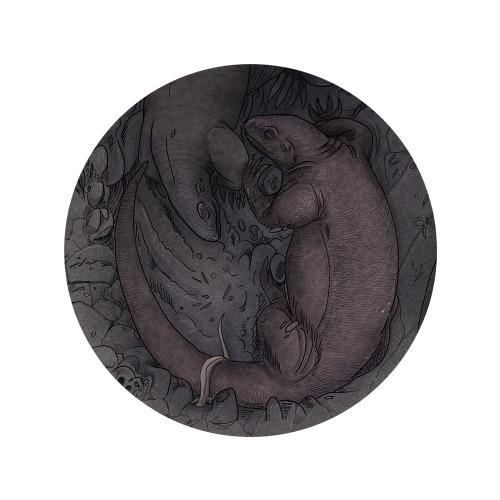#tetrapod
During the Early Carboniferous, around 330 million years ago, the region that is now the East Kirkton QuarryinScotland was located close to the equator, with a lush tropical climate and volcanic hot springs dotting the landscape. It preserves fossils of some of the earliest known fully terrestrial tetrapods, and a recent discovery shows how some of these animals were already experimenting with the shapes of their feet to better get around on land.
Termonerpeton makrydactylus is only known from a partial skeleton, and shows a mix of anatomical features that make identifying its exact evolutionary relationships rather difficult – but it was probably a very early reptilomorph, closer related to amniotes than to lissamphibians. It may also have been very closely related to the equally enigmatic EldeceeonandSilvanerpeton from the same region, but was almsot twice their size with a estimated total length of around 70cm (2'4").
It would have resembled a rather heavily-built lizard-like or salamander-like animal, with fairly stumpy legs and probably lacking claws on its digits. While it would have had spindle-shaped scales on its underside, and possibly small rounded scales along its sides and back, these were bony structures embedded in its skin and probably weren’t very visible externally in life.
ButTermonerpeton’s most surprising feature was its proportionally large feet with especially elongated fourth toes, which would have helped to extend its stride length for energy-efficient terrestrial locomotion and to stabilize its movement on unstable surfaces – a much more “advanced” amniote-like arrangement than expected in such an early reptilomorph, and convergently similar to to the foot shapes of some modern lizards. Its fourth toe was also unusually chunky, suggesting it may even have been bearing most of its weight on just that one digit when walking.
———
Nix Illustration|Tumblr|Twitter|Patreon
Post link
Tiktaalik - the fishapod
Model by Tyler Keillor and this particular set up on display at the Harvard Museum of Natural History
When: Late Devonian (~375 million years ago)
Where: Found on Ellesmere Island in Nunavut, Canada
What:Tiktaalik is a very critical specimen on the line of tetrapod evolution. In the tetrapod family tree it falls between sarcopterygians (‘lobed fin’ fish) that looked much like the living Coelacanth and more advanced tetrapods, such as Acanthostega.The discovery and announcement of Tiktaalik was very exciting, as fossils on both side of transitional period were known for a long time, but nothing really in the middle. Of course as with the discovery of any 'missing link’ now we have two more 'links missing’: one on either side of Tiktaalik ;). The most important part of the specimen is the anatomy of its forelimb - there was a well developed wrist inside the fin of Tiktaalik! Not only that, but it possibly has the first 'fingers’ seen in the tetrapod lineage. Unfortunately the back end of Tiktaalik is unknown… for now!
In life Tiktaalik would have been an aquatic animal, as its limbs could not support its weight on land - but they would have been very helpful for maneuvering the creature around the shallow waters of prehistoric Canada. Based on the spiracles - openings behind the eyes- of the skull it has been preposed Tiktaalik could have had a form of primitive lung.
If you want to know more about Tiktaalik - check out its website at: http://tiktaalik.uchicago.edu/. And for more in depth reading, I cannot recommend the book 'Your Inner Fish’, written by the discover of Tiktaalik - Neil Shubin, enough! It is a really great explanation of how Tiktaalik fits into the evolution of tetrapods and explaining homology in general! Shubin has done a fantastic job of promoting public science education using this great Tiktaalik specimen as a starting point.
Just look at all of these models getting ready to go out to museums. Maybe one is near you!

Post link
Matschie’s Tree Kangaroo (Dendrolagus matschiei) at Woodland Park Zoo (5) by Nick Michalski






